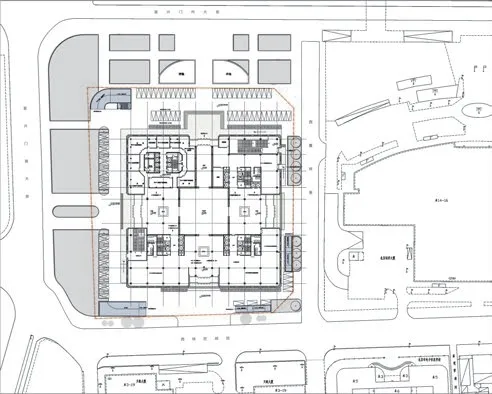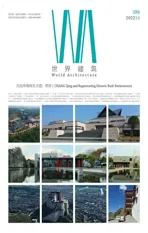教育信息化大厦方案设计,北京
2022-10-25支文军,ZHUYayun
教育部信息化大楼扩建工程基地位于北京复兴门旧址近旁,北临长安街,西靠复兴门外大街,东望远洋大厦,南接西铁匠胡同。中国教育电视台塔楼矗立在基地北侧。2012 年由常青领衔的同济大学建筑设计研究院概念方案从全国88 个征集方案中获选。方案拟以保留该塔楼为前提,存旧续新,并以抵近基地空间属性和场所特质为导向,寻求唤起复兴门的城市记忆。
方案一减层保留现状楼体结构,在其东侧加建一座等高塔楼与之对称相连,南面新建一座符合限高的塔楼与北楼高低对接,状若“太师椅”,既满足了扩建要求,又改善了长安街的街廓尺度感。方案二完整保留现状楼体结构,向东和南两个方向扩建,形成存旧续新的“八仙桌”态势,虽然大幅增加了建筑的外廓,但也通过东西向的空透门洞,减弱了整个建筑的体量感,回到了“复兴之门”的设计初心。设计要点可以概括为:
The Information Technology Building extension project of the Ministry of Education is located close to the historic site of Fuxing Gate (Gate of Revival) in Beijing, bordered by Chang'an Avenue to the north, Fenxingmen Outer Street to the west, the Yuanyang Plaza to the east, and West Tiejiang Alley to the south.The Tower of the China Education Television dominates the northern section of the site. In 2012, the team from Tongji Architectural Design(Group), led by Professor CHANG Qing, had its conceptual design chosen from a nationwide pool of 88 submissions. The design endeavours to preserve the old and add the new on the premise of keeping the existing tower, and it seeks to revive the urban memory of the Fuxing Gate by stimulating its spatial qualities and genius loci.
其一,以“绿地广场—泮池—月台—主入口—过厅—八角厅”等层层递进,形成空间序列,并通过竖向交通核与屋顶四合院——“空中之庭”相贯连。底层平面为中国经典的九宫格图式,以四维四隅的楼体,环绕中央八角厅,形成传统与现代相类比的平面构图关系。
其二,除保留的现楼体竖向交通核外,其余新建楼体分设3 个竖向交通核,并以内环廊、过厅、疏散厅、天桥等将楼体各部分在水平和竖向连为一个整体。
其三,摒弃仿古大屋顶,以5 个宝蓝顶盖、栗色檐下的中国风屋顶组合,隐喻传统“五凤楼”意境,在平顶层叠的钢结构逻辑中抽象显示檐下“铺作”的中国古典意象。
其四,墙身—基座划分推陈出新,中西交融,采用黄金比,以石材嵌钢的中式线框衬托西式浮雕壁龛,以几何化的古典回纹和折角纹作为主要装饰母题。该获选方案因故未能实施。□
The first design option is to reduce the height of the existing building while preserving its current structure, and connect it symmetrically to an equal-height tower added to the east. A new tower that complies with the height regulations will be built in the south and connected with the northern towers to form the shape of a Taishi (Grand Preceptor) Armchair,which will not only satisfy the extension requirements but also improve the streetscape of the Chang'an Avenue. The second option is to extend in both the east and south directions while retaining the structure of the existing building, creating the look of a Baxian Square Table (Eight Immortals Table) in the spirit of "preserving the old and adding the new".Despite significantly expanding the building'svolume, this design decreases the heaviness of the structure by opening the east-west portal,reverting to the original intention of the "Gate of Revival". The primary design concepts can be summarised as follows.
Firstly, the site plan is formed by the orderly progression of the green square, pan(semicircular) pond, front platform, main entrance, entry hall and octangular hall, and is connected to the Sky Court rooftop courtyard via a vertical traffic hub. The ground floor plan resembles the traditional Chinese nine-squaredivision pattern, with an octagonal hall in the centre surrounded by a four-dimensional, fourcornered structure, creating an analogy between tradition and modernity.
Secondly, the interior traffic flow is organised with three more vertical traffic hubs set up in the newly designed towers in addition to the existing one, and the internal circular corridors, entrance halls, evacuation chambers,and sky bridges are used to connect all parts of the buildings horizontally and vertically.
Thirdly, instead of replicating the conventional big-roof style, the five sapphire blue canopies and marron eaves with Chinese resonance provide a metaphor for the traditional"Five Phoenix Pavilion", abstractly evoking the classical imagery of the bracket-layers (puzuo)under the eaves against a backdrop of the cascading steel framework on the flat roof.
Fourthly, the design of the vertical composition of the wall and base, following the golden ratio, is an East-West blended innovation.It enhances the Western-style relief niches with a stone-and-steel-inlaid Chinese wireframe and uses the geometry-inspired classical rectangular spiral and folded corner motifs as its primary ornamental theme. This design concept was eventually not implemented.□ (Translated by ZHU Yayun)
项目评论
由常青教授主持设计的“中国教育信息化大楼”方案,基地在民国初开凿的长安街穿城而过之复兴门遗址近旁。在研究基地场所特征与环境脉络及功能定位关系的基础上,他提出了“复兴之门——国家远程教育新地标”的设计理念,试图从史地维度找到城市记忆的时空坐标,以确定建筑生成的价值取向,将场所特征融入有意味的长安街国家教育电视台大楼扩建工程。
为此,设计首先在大楼的新旧部分如何有机结合、形成共生整体上展开,在保留国家教育电视台主体塔楼的前提下进行新旧交融的整体重塑,守正创新,完成“复兴之门”的意象再现;其次,在建筑造型上寻求“古韵新风”,即古韵而不复古,新风而不唯新的理性思辨和设计策略,为完善长安街的古都风貌天际线和新地标做出贡献;再次,在建筑形体塑造上,常教授先后提出了“复兴之门”多个创意比选方案,如“太师椅”“八仙桌”“五凤楼”等。显然,设计在这里更注重建筑的场所感和象征性,而建筑形式不过是场所精神外化的具象表达而已。
总之,这是一个基于特定场所属性和环境条件,将历史意识融于现代设计的典型创意方案。
支文军
《时代建筑》主编中国建筑学会理事

4 首层平面Ground floor plan
Comments
The China Education Information Technology Building, designed by Professor CHANG Qing, is an extension of the China Education Television Building on Chang'an Avenue. It is located near the historic site of Fuxing Gate (Gate of Revival),which was cut through by Chang'an Avenue at the beginning of the Republic of China (1912-1949).The architect proposed the design concept"Gate of Revival: New Landmark for Distance Learning in China" after conducting research into the site's characteristics, environment,and functional positioning. He endeavours to pinpoint the temporal and spatial coordinates of urban memory from the perspective of history and geography, thereby establishing the value of architectural form-making and integrating the site's qualities into the project.
To this end, the design focuses first on the organic combination of old and new and the creation of a symbiotic whole, so as to carry out the overall reshaping of the building complex, preserve and innovate, and complete the reappearance of the "Gate of Revival" imagery, on the premise of preserving the original main tower of China Education Television. Second, in order to contribute to the improvement of the ancient capital's skyline and the creation of new landmarks on Chang'an Avenue, it also pursues a "new style with ancient resonance" (guyun xinfeng) in the architectural form, which refers to the critical thinking and design strategy of favouring "ancient resonance" but not simply imitating the old, and encouraging "new style" but not blindly adopting the new. In terms of architectural form, the designer has provided a variety of images for the "Gate of Revival", including the Taishi (Grand Preceptor) Armchair, the Baxian Square Table (Eight Immortals Table), and the Five Phoenix Pavilion. Obviously, the design focuses more on the building's sense of place and accompanying symbolism, while the architectural form serves only as a figurative representation of the genius loci.
In conclusion, this is a quintessential design that incorporates historical consciousness into modern design, taking into account the qualities of the specific site and its surroundings.(Translated by ZHU Yayun)
